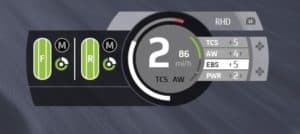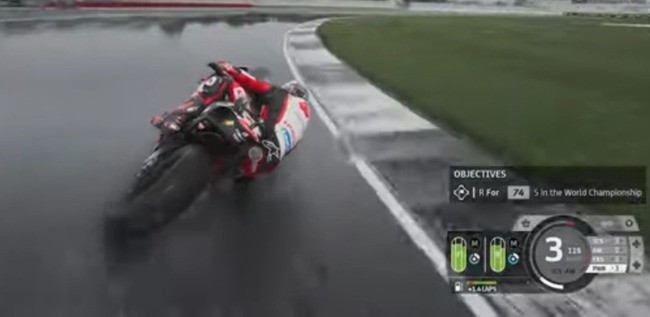It’s no secret among MotoGP gaming fans that racing in the wet on these games is brutally difficult. If you’re not used to it, you’ll find yourself falling off the bike nearly every single corner.
It’s always been this way – I remember playing MotoGP: URT well over 10 years ago and having the same experience. It’s much harder than racing in the wet on most 4 wheel racing games for example.
In this guide though, I’ll offer some suggestions on making it a bit easier to control the bike and lap circuits in wet conditions on the MotoGP games.
Note though, that these things only make it easier and relative terms. It’s never going to be easy to ride tracks in the rain on these games, and a lot of players understandably lose patience and quit out of wet races.
But there are a few things you can do to be more consistent. Let’s get started.
Tip #1 – Be Super Cautious and Gentle With Your Inputs
These bikes have even more fragile balance when in wet conditions, so whatever inputs you in the dry, try to make them 20-30% more gentle and gradual when in the wet.
This means:
- Brake earlier and more gradually (more on this below).
- Lean more slowly and gradually
- Apply the throttle out of corners more progressively.
Exiting Prolonged Corners – Need to be very careful with the accelerator here in the wet. Only apply gradually and only go to 100% when fully out of the corner and in a straight line again. Applying too much throttle too soon on exit will lead to the bike running wide and also losing grip at the rear. If you do still use assists, in the wet you need to pretend you aren’t using any traction control/throttle assist, because it’s about the same level of modulation that’s required.
In general, you need to be more subtle on your inputs to keep control of the bike and focus on consistency rather than pushing too hard for pace. Whereas your inputs in the dry when you know tracks well might be quite rapid, forceful and deliberate, in the wet, your inputs need to be more measured, gradual and restrained.
If you want, you can even stop short of applying 100% of the inputs on acceleration/braking, only sticking between 70-80% maximum unless on very long straights.
Tip #2 – Get All Of Your Braking Done Before Entering The Corner
This is the most crucial point. You need to brake only when the bike is fully upright and in a straight line, and get 100% of the braking done before you start leaning in for the corner. This means literally zero application of the brakes when the bike is leaning in any way whatsoever.
This is good practice even in the dry, but truthfully depending on skill and assists level, you can sometimes kind of cheat on these rules and get away with it on some corners in dry conditions.
Not so in the wet. You have to follow these rules strictly – every corner, every lap – when racing in wet conditions. Which can be hard if you’ve got into some bad habits and kind of do apply the brake a bit when leaning on some tracks because you’re used to getting away with it in the dry.
In the wet, you need to be stricter and more disciplined with yourself. Here’s how to tackle certain corner types:
Single corners after a straight – Start braking earlier than you would in the dry. Brake in a straight line and fully upright, and make sure you have slowed down all you need to before you even start entering the corner. Once you’ve scrubbed off enough speed, come off the brakes (and don’t apply them again at all during the corner), and start leaning into the corner. As you exit the corner, ease back onto the throttle again more gently than you would in the dry, depending on the levels of assists being used.
Multiple successive corners/chicanes – In more complex sections where you’ve got corners flowing after each other, again you need to not use the brake at all in these sections if the bike is continuously leaning in one direction or another. It’s all got to be done by either coasting or very light dabs on the power, and leaning, without applying the brakes at all.
Riding In The Wet On MotoGP – Example
Update – depending on your assists level, you can sometimes dab the rear brake when cornering in the wet – on some corners at some tracks. You’ll have to experiment by trial and error with doing this. But definitely avoid using the front brake at all when leaning into corners, as you’ll immediately fall off the bike.
Tip #3 – Adjust Your ECU Settings
Another little settings hack that can make riding in the wet easier is to adjust some of the parameters on your ECU dashboard:
- PWR – Reduce your power mapping setting to 2 or 1, which reduces the power output and therefore indirectly makes traction easier.
- TC – Increase your TC setting by 1 or 2 clicks to directly make traction easier.

Your ECU settings can be changed from the bike setup menu off track, and also during races on your ECU dash. See our article on ECU settings where we go into this in more detail.
Tip #4 – Stick To The Drying Race Line
This is another little tip that can give you a little more grip. In light or moderate rain conditions, a drying line will quickly start to form, where all the bikes have rode and pushed away much of the water from the track.
Try to stick to this dryer line as much as possible and not drift onto damp or fully wet parts of the circuit, which will offer you far less grip and make it more likely you’ll crash.
Tip #5 – Avoid Rumble Strips & White Lines
This goes back to the point about going for consistency rather than pushing for outright speed in the wet. It’s better to stay within the limits of the track, and avoid going onto any kerbing/rumble strips or painted while lines, when in the wet.
It can be dangerous doing these things even in the dry on MotoGP games, but in the wet it’s almost always going to lead you to fall off the bike. Keep away from the outer limits of the track and stay on the tarmac only for better grip.
Tip #6 – Increase Assists Level
If you’ve tried turning off some of the assists or Riding Aids in the dry, you might want to enable some of them again just for wet conditions.
More, specifically, you might want to increase the following by 1 click/step:
- Braking Input Modulation
- Acceleration Input Modulation
- Roll Mitigation Modulation (some games only)/Anti-rollover
- Cornering Input modulation.
On some games it’s broken down into a simpler Neural Aids setting for braking/steering/throttle. Whatever setting you have to braking/acceleration especially, try increasing it by one.
Also, if you normally turn the Rewind/Flashback feature off in the dry, it’s definitely worth turning it back on in the wet.
Having absolutely all the assists turned to maximum kind of lets the game handle everything and takes the fun out of it. But depending on your usual level of assists in the dry, you might have some wriggle room to increase them a bit just for the wet to make controlling the bike easier.
Tip #7 – Reduce AI Level
Most players don’t want to do this once they’ve got used to using a certain AI level that works for them in the dry. But honestly, riding in the wet can be so tricky that it might be necessary to avoid crashing multiple times, being sent right to the back and basically riding around on your own for 15-20 minutes only to finish stone dead last by 30 seconds+ (not very fun, but very common in wet races on these games).
If you know yourself well enough to know that even trying to follow the tips given above, you’re still likely to fall off multiple times in a wet race, it’s advised to lower the AI difficulty level by a lot to stay competitive and be able to recover from crashes.
Here are some very rough guidelines given your skill level in the wet:
- Falling off every corner/every other corner – Probably no AI level that will work. Better to cut your losses and quit out of wet races and practice in Time Trial instead.
- Falling off multiple times per lap – Try a very low AI level of 20% or less to give you chance to catch up.
- Falling off once per lap – I’d use 30-40% AI and make sure bike recovery/retrieval is set to disabled, which is the easier option (respawns you back on the bike automatically if you fall off, meaning you lose less time).
- Some laps OK but falling off few times per race – Still keep the AI low at around 40-50% to give you chance to catch up.
- Fall off once per wet race – 50-60% might work.
- Consistent, but slow in the wet – Stick at around 60% to stay competitive.
- Consistent and good pace in the wet – Use your normal difficulty, perhaps dropped by 5-10 clicks to be safe.

